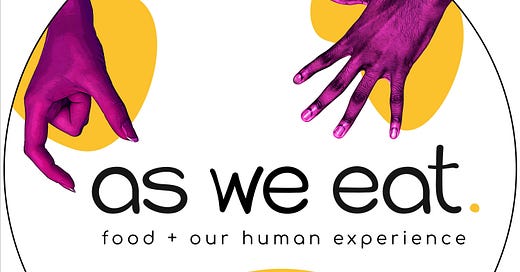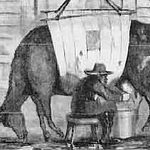Harnessing fire has helped to create culture, define our place in the animal kingdom, and allowed us to create some pretty tasty morsels. Join us for our 25th episode as we discuss our favorite campfire foods and the memories associated with them.
Campfires inspire thoughts of beautiful summer nights where campers draw together around a symbolic, temporary hearth. We think that just about anyone would agree to the element-ness of cooking over fire as well. Everything within our modern kitchen from the stove to the very pots and pans we use stems from the same basic principle that once upon a time, humans discovered that fire made food taste good. And thus the concept of cooking was born.
For this episode, Kim and Leigh dig into both memories of camping with family and friends as well as the histories of notable campfire cooking favorites - foil packets and s’mores.
Foil Packet Cooking
As a modern camper, Kim always had access to tools that make cooking very similar to how her family would cook & eat at home. Neither parent was into rustic camping and most camping meals were prepared over the trusty and very beloved Coleman camping stove. As a teenager, Kim started experiencing food cooked directly with fire.
Obviously it started with s’mores - that indelible treat of toasted/roasted marshmallows combined with chocolate and graham crackers - but eventually graduated to foil packets (some call them Hobo Packets) assembled with all manners of ingredients and cooked on a grate over open campfire flames or nestled near slow-burning coals.
Hobo packets are virtually synonymous with scouting with dozens of anecdotal stories about the “classic” Boy Scout recipe combining ground beef, potatoes, carrots, maybe cabbage, and ketchup. The romantic history of the hobo pack, if you will, is that itinerant people during the Great Depression of 1929 - 1933 would scrounge meals from any source possible using vegetable peelings, odd cuts of meats, or vegetables that could be stolen, bartered, or foraged and then cooked together.
Oral histories about food & cooking by itinerant people are more about mulligan or community stews than individualized tin or aluminum foil packets and I’m truly inclined to believe that foil cooking is more likely a post-WWII invention as vast ranges of aluminum products made their way into grocery stores in the 1950s and 1960s.
The process of making a Mulligan stew was described in the Sunday Oregonian newspaper on January 21, 1900 as a collaborative effort in scrounging performed by a small group of people - one builds a fire and rustles a can, another procures meat maybe by stealing a chicken, another finds vegetables maybe potatoes and onions, another finds bread so on… It’s called a Mulligan because this is considered a bastardized version of an Irish stew but versions of this meal are also known as burgoo in Appalachia or booyah in the Upper Midwestern US.
Traditional scouting recipes for foil packets focus on ease. The real beauty of foil packets is that there are a multitude of flavor and ingredient combinations to try. Some examples:
Chicken, eggplant, tomato, lemon, and garlic
Sliced bell peppers, onions, carrots, and corn with mesquite spices
Minute steaks with mustard, mushrooms, finely sliced leeks
Sliced sausage, potatoes, onion, and sauerkraut
Trout filet, lemon, butter, parsley
Ham slice topped with pineapple slice with (canned) sweet potatoes
Drumsticks indiana which involves mixing hamburger with cornflakes, egg, onion, and spices and forming a kebab
Tuna burgers made from canned tuna, sandwich spread, and relish with a slice of tomato
S’Mores
There is something undeniably great about cooking food on sticks over a fire, and especially satisfying about foraging for the perfect green stick that’s straight enough, long enough, and sturdy enough and in that focused search for the perfect roasting stick, you notice so many things around you that you may have missed. Leigh fondly recalls finding edible fruits on the forest floor, pine cones to put out during the holidays, or just all the colors of green in the forest.
One of her favorite foods on a stick is a roasted marshmallow. It’s an intensely personal act taken on by the individual who is going to consume it. We were curious about whether the famed marshmallows we love for s’mores have any relationship to the marshmallow plant. The answer is yes and no.
Marshmallow is a mallow plant native to Europe and Asia. It grows in marshes - hence the marsh part of the nomenclature. Throughout the ages it has been used for medical purposes as well as a confection. Apparently a mixture of marshmallow root, gum, egg whites, and sugar were used as a pectoral remedy - marshmallow root has anti-inflammatory purposes.
As far back as 2000 BC, Egyptians combined marshmallow root with honey and nuts creating a sweet treat and like so many of the luxurious foods that we’ve talked about, were reserved for the rich and famous. In this case, the gods and Pharaohs.
The modern marshmallow first appeared in France in 1850. They were not the mass market confection that we know today. They were super labor intensive…each marshmallow had to be individually molded.
But by the 1900’s they were available as penny candy and were mass produced thanks to the invention of the starch mogul system - which essentially is a machine that lays out huge tray of cornstarch, stamps the mold into the starch and then the marshmallow fluff is dropped into the molds.
It was around this time … the late 1800’s and early 1900’s that marshmallow roasts became popular. A newspaper article titled “Marshmallow Roasts, A New Fad which Affords Amusement and Candy” from dated August 8, 1892 in the World Chicago Daily Tribune exclaims marshmallows roasts as “newest thing in summer resort diversions”
It goes on to give directions on how to setup a marshmallow roast, including providing enough marshmallows for invitees and to affix the marshmallow to a skewer, waiting until the fire has died down to embers, dexterously turning the marshmallow which requires some skill because they are “highly flammable and will take fire if not prudently handled”
The summary conclusion is that “when done they are morsels of the gods, - something I’m sure the Pharaohs would agree with - resembling in flavor the exquisite meringue, with a delicious nutty and crusty outside.” But it was slightly salacious at the close of the article indicating that “marshmallow roasts are an excellent medium for flirtation, mutual regard between a young lady and gentleman being appropriately exhibited by nibbling the marshmallows off each other's sticks. Accordingly the idea is sure to grow in favor." This seems to be one time when you must think of someone other than yourself when roasting a marshmallow on the campfire.
Like so many of the foods that we have covered, you can’t pin an exact date or person who invented the S’more. Sandwich cookies filled with jam and cream fillings were popular in Victorian-era cookbooks and 20th century American cookbooks contained recipes for chocolate sandwiches and marshmallow sandwiches and then there were Moon Pies, Scooter Pie and Mallomars that were being produced by American food companies.
But it wasn’t until “Tramping and Trailing with the Girl Scouts,” the 1927 cookbook by the Girl Scouts of America that the first recorded recipe for the S’more appeared. The recipe called for 8 sticks, 16 graham crackers, 8 bars of plain chocolate, and 16 marshmallows. It directed the roasting of 2 marshmallows over coals, and then placing them inside the graham cracker and chocolate bar sandwich.
The name likely came from the last line of the instructions which says, “though it tastes like “some more” one is really enough.
Campfire Food Transcript
🎧 Click here for the full, interactive transcript of this episode 🎧
Sources We Found Helpful for this Episode
Books We Think You’ll Enjoy Reading
The Camp & Cabin Cookbook by Laura Bashar
Feast by Firelight: Simple Recipes for Camping, Cabins, and the Great Outdoors by Emma Frisch
Dirty Gourmet: Food for Your Outdoor Adventures by Dirty Gourmet
The Campout Cookbook: Inspired Recipes for Cooking Around the Fire and Under the Stars by Marnie Hanel
Camp Cocktails: Easy, Fun, and Delicious Drinks for the Great Outdoors by Emily Vikre
S’mores by Lisa Adams
Recipes You Really Need to Try
Cub and Boy Scouts Recipes - Boy Scout Trail
Foil Pack Dinners - Scouters Mom
Foil Cooking Ideas - MacScouter
How to Make S’mores (4 Ways!) - Dinner then Dessert
Episodes We Think You’ll Like
Wedding Foods: Undigested Squid Beaks, Turtle Doves and Candy-Coated Almonds
Dutch Ovens: Wedding Gifts, Symbols of Independence, and Members of the Family
We would love to connect with you
AsWeEat.com, on Instagram @asweeat, join our new As We Eat community on Facebook, or subscribe to the As We Eat Journal.
Do you have a great idea 💡 for a show topic, a recipe 🥘 that you want to share, or just say “hi”👋🏻? Send us an email at connect@asweeat.com
Review As We Eat on Podchaser or Apple Podcast. We would like to know what you think.
And please subscribe to As We Eat, Going Places. Eric and Leigh will be traveling in their converted van sharing stories of food culture from the road.
We would love it if you would consider becoming a supporting subscriber. For just a few dollars, you can get access to exclusive content including our Recipe Box Roulette “card” game, more in-depth articles, more recipes and you’ll help keep our oven lights on!
Thank you for listening to the As We Eat Podcast. This post is public so share it with a friend - or three :)


























Share this post